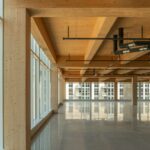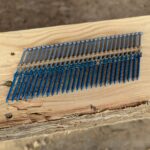Expert Tips
Floor Vibration Analysis in Light-Frame Projects
Covers several methods for analyzing and limiting floor performance for vibration in light-frame wood buildings.

Vibration of light-frame wood floor construction can be a significant occupant comfort issue. However, achieving acceptable levels of floor vibration is not a code requirement. As such, it is possible to design a code-compliant wood floor structure that produces annoying or unacceptable levels of vibration due to standard foot traffic.
A variety of factors can affect a floor’s vibration performance, including:
- Presence of concrete topping or other massing materials
- Thickness/stiffness of floor sheathing
- Stiffness, spacing and span of floor joists/trusses
- Presence, size and spacing of blocking/bridging/strong backs
- Presence of direct-applied ceiling
- Stiffness of joist supporting elements (i.e., beams, bearing walls)
- Presence of partition walls
Several vibration analysis methods have been published, each of which takes into account some or all of these variables.
What constitutes an “acceptable vibration level” is subjective, but level of performance is generally measured by floor frequency. According to an article by Frank Woeste and Dan Dolan, “Occupants are very sensitive to vibrations in the range of 7-10 Hz. In theory, joist designs (or floor system designs) that vibrate well above 7-10 Hz should be judged by the occupants as acceptable simply because they can’t feel the higher frequencies. As a general rule, wider joist spacing (24 inches on center versus 12 inches on center) will produce a higher frequency because deeper members, having a greater bending stiffness (EI), will be required to meet building code deflection requirements.” However, studies by FPInnovations have shown that this approach may be “too simple to differentiate the vibration behavior of the floors with and without concrete topping, and to control vibration in a broad range of light-frame wood joisted floors. For example, a long-span light-frame wood joisted floor with a concrete topping can have frequency below 14Hz, but the vibration performance can be very good.”
This leaves two main questions:
- What criteria should floor vibration be checked against, and
- What method should be used to determine vibration performance of a floor?
The two most common methods for analyzing and limiting floor performance for vibration are deflection limit and floor frequency.
A simple, prescriptive method of limiting vibration is to limit deflection, usually to higher criteria than is required by the IBC. This method, commonly called the uniformly distributed load (UDL) deflection method, attempts to control vibrations by limiting the static deflection of a floor under a uniform design load. For example, one floor joist manufacturer has suggested a live load deflection limit of L/480 for commercial floor spans up to 15′ and a live load deflection limit of L/600 for spans above about 18′ (between 15′ and 18′, they recommend a maximum live load deflection of about 3/8″). According to FPInnovations, “This approach assumes that the allowable deflection for controlling vibration is linearly proportional to the span of a floor. It basically means that the longer the span, the more deflection is allowed. This may explain why it was found in previous studies of light-framed floors that the UDL deflection method did not eliminate vibration issues in the long-span category. Therefore, to avoid excessive vibrations in floors, the engineer needs to have a good judgment to be able to select a proper UDL deflection limit according to the floor spans.”
Matching the consensus of the FPInnovations text, some engineers conclude that the live load deflection limits mentioned above can be an effective vibration control measure for spans up to about 22′. However, for spans above 22′, some vibration control calculations show that deflection limit may still be an ineffective method of controlling vibration.
Perhaps the most widely known frequency-based vibration analysis method today is that from Woeste and Dolan. Their method, developed by Thomas M. Murray in the article “Building floor vibrations,” which appeared in Engineering Journal in 1991, calculates the fundamental frequency of the typical floor joists based on the floor joist stiffness, span and applied dead loads. This method recommends limiting floor frequency to a minimum of 14 Hz for furnished rooms or 15 Hz for empty rooms. Past experience shows that this can be an effective quick check tool but it can underestimate the floor’s performance due to unaccounted for measures such as the presence/lack of a floor topping, blocking, ceiling, etc.
In order to address what they consider perceived inadequacies with the above mentioned analysis methods, FPInnovations has proposed utilizing a new analysis method. This method calculates the maximum permissible span for a given assembly based on a combination of floor stiffness and mass, with options for increasing the allowable span if blocking, bridging, strong backs or other stiffening measures are used.
Several engineered wood floor joist and truss manufacturers have developed proprietary software which includes floor performance ratings that take into account many of the same considerations as the FPInnovations method. These ratings are based on perceived acceptance of a floor’s vibration performance. Examples include Weyerhaeuser’s TJ Pro Rating and Redbuilt’s Floor Choice Rating.
Other sources of information:
- Redbuilt has published a short document on floor performance.
- Weyerhaeuser has published a technical bulletin on floor performance.
- APA has several publications on floor vibration design, including Form D720 and Form E710
A related question that arises less frequently is that of vibration performance of wood beams supporting floor joists/trusses. The Dolan method mentioned above does provide an equation for checking the combined floor vibration performance of a typical floor framing member with the vibration performance of the supporting beam, as does AISC Design Guide 11. However, checking wood beams for vibration is not commonly done. Best practices include limiting deflections and verifying that the combined performance of the system will still produce acceptable levels.



